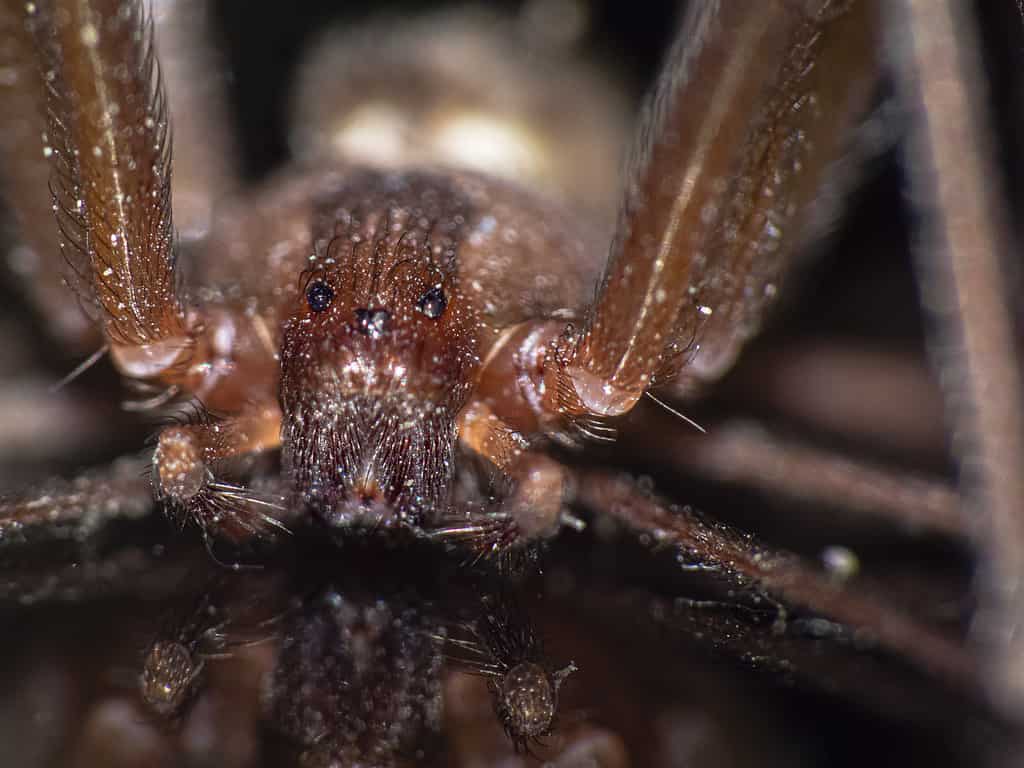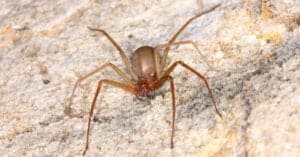A brown recluse spider or Loxosceles reclusa is a venomous recluse spider that produces necrotic venom. These spiders are also known as “violin” or “fiddle back spiders.” The brown recluse has a dark brown cephalothorax and is violin-shaped. Its neck points towards the abdomen. However, what makes these spiders unique is the six eyes that appear in pairs. In addition, there is a space that separates the pair of eyes. Here is how to identify a brown recluse spider.
Key Traits That Make It Easy to Identify a Brown Recluse Spider
While some spiders may exhibit some of these characteristics, a recluse spider should have the following. Mastering these traits will help you properly identify the brown recluse spider and avoid unpleasant experiences.
- The spider has six eyes arranged in pairs. This arrangement is unique, with one pair in front and two on either side of the spider’s body.
- Its cephalothorax is dark and violin-shaped.
- Legs are uniformly colored – they have no bands or stripes
- The abdomen is uniformly colored. The color may range from cream to dark brown color. The color it takes depends on what it has eaten. However, note that the abdomen will not take two color pigments simultaneously.
- The spider has no spines on its legs. It only has fine hair.
- The recluse spider hides its web and never makes one in the open.
- The spider has a 3 – 8 inch body length.
Significance of 6 Eyes as a Trait
Unlike other spiders with eight eyes, the brown recluse has six eyes. You may not see the eye pattern easily. However, it is possible to identify the pattern with magnification.
While most spiders will have eight eyes, a few other species also have six, like the brown recluse. A good example is the spitting spider with similar eye patterns but no violin abdomen. What’s more, it has more than one pattern on the legs.
Importance of the Dark Violin Pattern on the Spider
One other way to identify the brown recluse spider is its unique pattern. However, one has to be careful when identifying the violin pattern. Some spiders have been submitted as Brown recluse spiders, only to be found to be cellar spiders with eight eyes.
The Kukulcania spider has also been confused with a brown recluse spider because of the pattern, but it has eight eyes and black spines, so it does not qualify as a brown recluse.
Uniformity of Color in the Abdomen and Legs
One way to know a spider isn’t a recluse, even though similarities are the color differences. Recluse spiders do not have more than one color pigment on the legs and abdomen.
Funnel weaver spiders are very similar to recluse spiders in appearance, except that they have different color shades.
Brown Recluse Spiders Have Hairs and No Spines
One striking trait about recluse spiders is that they have no spines sticking out perpendicularly like most other spiders. This is how you differentiate the orb weaver from the recluse since it has spines instead of hairs.
The Recluse Web is Out of Sight
If you spot an obvious web in the woods or between trees, you can be sure that the spider is not a brown recluse. The recluse web is almost invisible. One other thing that confirms the recluse spider is its size. It should not be more than ½ an inch long.

The brown recluse has six eyes arranged in pairs. This arrangement is unique, with one pair in front and two on either side of the spider’s body.
©iStock.com/Wirestock
Where are Brown Recluse Spiders Typically Found?
It is not easy to spot a brown recluse spider. The spiders have a 2 to 4-year lifespan. They often hide during the day as they stay in dark corners in the daytime away from predators and human interference. They only come out at night to hunt and sometimes end up in homes where they can bite when they feel trapped.
However, it is extremely rare for brown recluse spiders to bite. They are typically found in 15 states in the US. These include Alabama, Arkansas, Georgia, Illinois, Indiana, Iowa, Kansas, Kentucky, Louisiana, Mississippi, Missouri, Ohio, Oklahoma, Tennessee, and Texas. Transporting these spiders to other areas in boxes where they could be hidden is possible.
Their spider webs are found lower on ground level. The webs are a disorganized and grayish-off-whitish color. Usually, spiders prefer living in dark, dry, and undisturbed areas.
You will likely find them in specific areas, including rotting tree barks, rubble/ stone piles, woodpiles, attics, barns, sheds, drapery folds, crawl spaces, shoes stored outside, and hollow tree sections. It is also possible to spot some in folded clothes.

The brown recluse spider is often identified by the violin-shaped marking on its body.
©Nick626/Shutterstock.com
What to Do When a Brown Recluse Spider Bites?
A recluse spider bite is extremely rare but not impossible. Check for two fang-like marks on the bite area. Since the bites are practically painless, it is difficult to notice until a blister forms. Seek medical attention immediately if you suspect a spider bite. It is even more urgent if you suspect the bite is from a venomous brown recluse spider. Prompt medical attention is vital to avoid tissue death. There is nothing to worry though. Most bites heal in a few weeks with little to no complications.
However, younger children and the elderly with pre-existing medical conditions may have severe reactions. They tend to be more sensitive.
Victims may experience nausea, vomiting, dizziness, chills, rash, and fever in such cases. Experts from CDC advise seeking medical help if you suspect a bite from a brown recluse spider.
Generally, the brown recluse spider is non-violent species. It does not attack unless threatened. Moreover, it does not hunt humans and will most likely remain harmless. However, if you are worried about the presence of these spiders in your home, consider getting rid of them.
Do this by:
- Getting rid of clutter in and around your house
- Control insect infestation as they are the spider’s primary food source and act as a major attraction.
- Seal cracks and gaps in the windows
- Set glue traps along the spider’s paths
- Clean the house regularly to get rid of all dirt.
- Call professional pest control if the issue is out of hand.

If a brown recluse bites you, prompt medical attention is vital to avoid tissue death.
©Robert D Brozek/Shutterstock.com
The photo featured at the top of this post is © Physics_joe/Shutterstock.com
FAQs (Frequently Asked Questions)
How do you know if it's a brown recluse?
What gets mistaken for a brown recluse?
What happens if a brown recluse bites you?
Thank you for reading! Have some feedback for us? Contact the AZ Animals editorial team.







